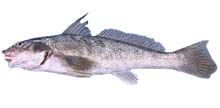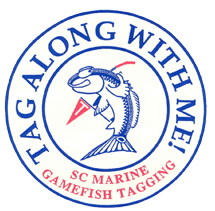Marine - Species
SC Species Regulations for Southern kingfish
Saltwater Fishing License required.
Not managed in South Carolina. No size, creel, or season limits.
Southern kingfish (Menticirrhus americanus)
General Description
Elongate, silvery-gray or tan, belly white; 7 – 8 faint dark bars on sides. Margins of fins often dark; pelvic, anal, and caudal fins often yellowish. Mouth small and inferior; single short rigid barbell on chin.
Average Size
6 – 10 inches, 0.5 pounds
South Carolina State Record: 2 pounds, 10 ounces (1968);
maximum age: approx. 6 years (majority of fish rarely survive more than 3 years).
Habitat
Adults and juveniles occur over muddy or sand-mud bottoms in shallow coastal water and estuaries. Also common along beaches, near inlets and mouths of larger coastal sounds; juveniles sometimes in upper estuaries.
Reproductive Cycle
- Mature by age 1; approx. size at maturity: males – 5.3 inches, females – 7.5 inches.
- Move offshore to spawn April – September. Larger individuals may return to summer habitat after breeding.
- Larvae enter nearshore waters late spring and utilize estuaries and beaches as nursery grounds. Young fish move seaward as they grow.
Foraging Habits
- Use chin barbel to locate bottom prey in estuaries and in the surf. Feed primarily on marine worms, crabs and shrimp. Larvae feed on zooplankton.
Availability/Vulnerability to Harvest
- Commonly called “whiting,” and the most abundant of three kingfish species in South Carolina.
- Tolerate greater salinity and temperature ranges than northern and gulf kingfish. Inhabit state waters year-round; taken inshore from piers and bridges, and in the surf. Inshore harvest peaks during late spring and early fall migrations. Overwinter in deeper water offshore.
- Conservation concerns: degradation and loss of estuarine and nearshore habitat; potential for significant recreational harvest; potential for significant mortality as by-catch in southeast U.S. shrimp trawl fishery.
Literature Cited
Bearden CW. 1963. A contribution to the biology of the king whitings, genus Menticirrhus, of South Carolina. Contributions from Bears Bluff Laboratories no. 38, Wadmalaw Island, SC. 27 pp.
Fischer W. 1978. FAO identification sheets for fisheries purposes: western central Atlantic (fishing area 31) volume 1 – 7. Food and Agriculture Organization of the United Nations, Rome.
Goldstein RJ. 2000. Coastal fishing in the Carolinas: from surf, pier, and jetty. John F. Blair Publisher, Winston-Salem, NC. 243 pp.
Moore CJ, M Barkley. 2005. South Carolina’s guide to saltwater fishes. South Carolina Department of Natural Resources, Special Publication. Columbia, SC. 132 pp.
Murdy EO, RS Birdsong, JA Musick. 1997. Fishes of Chesapeake Bay. Smithsonian Institution Press, Washington D.C. 324 pp.
Sikora WB, JP Sikora. 1982. Habitat suitability index models: Southern kingfish. US Dept. Fish Wildl. Serv. FWS/OBS-82/10.31. 22 pp.
Smith JW, CA Wenner. 1985. Biology of the southern kingfish in the South Atlantic Bight. Trans Amer Fish Soc 114: 356-366.
Wenner CA, P Webster. 2005. Kingfishes. In: Comprehensive Wildlife Conservation Strategy. South Carolina Department of Natural Resources, Columbia, SC. Available: https://www.dnr.sc.gov/cwcs/pdf/Kingfish.pdf. Accessed: December, 2009.


